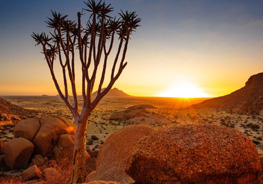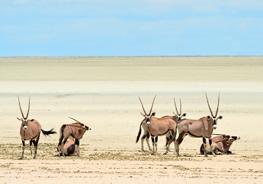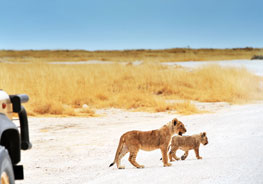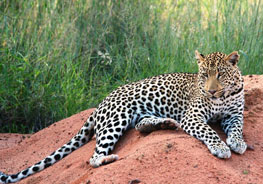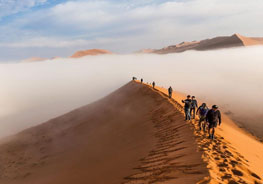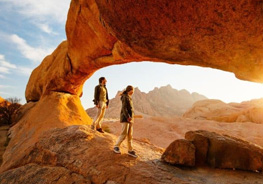Call Us
8:00am - 17:00PM
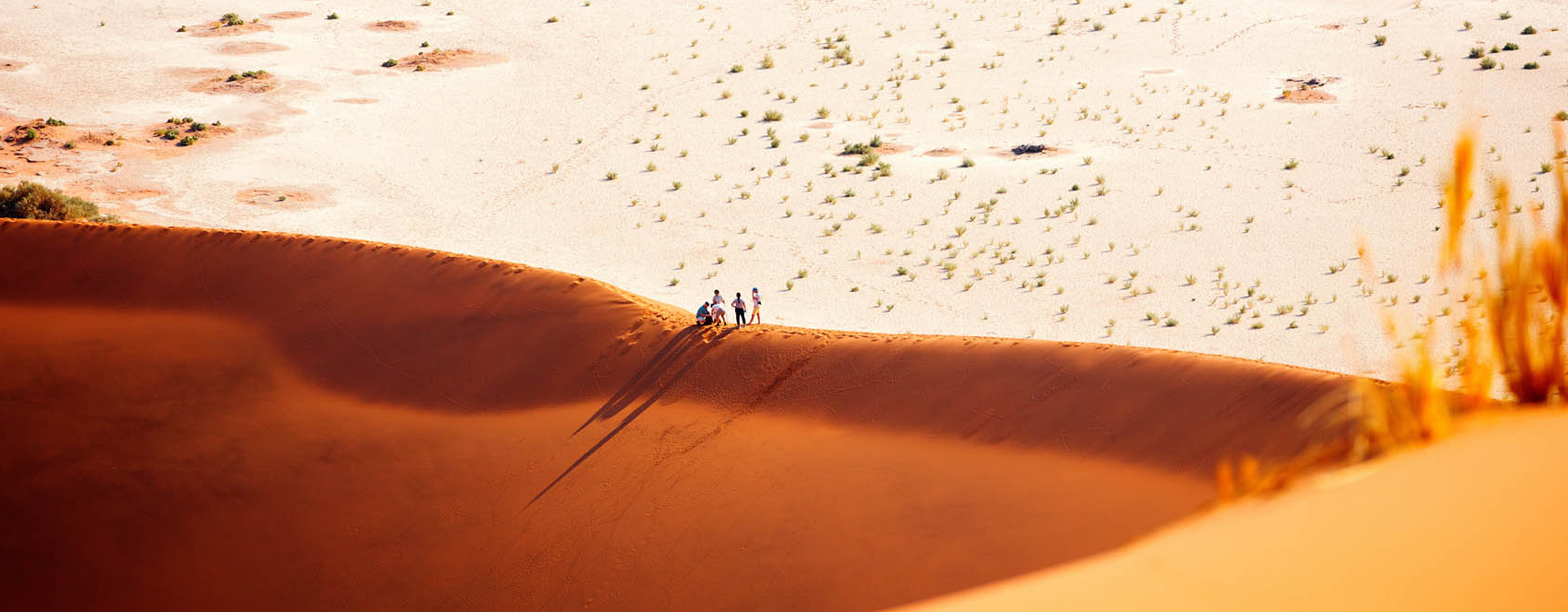
Namibia Travel Facts
Namibia
Travel Facts
At first, Namibia, seems a like a country’s filled with deserts and its large sand dunes, but Namibia is much more that. Let’s us take you through some most fascinating Namibia Travel Facts. By readings all these facts, you will feel like you’re actually on Namibia Safaris, and enjoying its adventure and watching its wildlife, with out even stepping into this country.
Glimpse Of Namibia Travel Facts
Namibia Geographical Facts
Namibia Climate And Weather
Namibia Attraction Facts
Namibia Wildlife Facts
Namibia National Parks Facts
Namibia Photography Facts
Namibia Food Facts
Namibia Cultural Facts
Namibia Festivals Facts
Namibia Adventure Activities
Namibia Conservation Facts
Namibia Travel Requirements Facts
Namibia Is Waiting For You!
Glimpse Of Namibia Travel Facts
Before, we proceed into the depth of Namibia Travel Facts, here is a quick review, of Namibia, that will give you a brief information.
|
Category |
Fact |
|---|---|
|
Location |
Southern Africa |
|
Capital |
Windhoek |
|
Currency |
Namibian Dollar (NAD) |
|
Official Language |
English |
|
Population |
2.54 million (2021) |
|
Area |
825,615 km² |
|
Climate |
Arid and semi-arid |
|
Popular Attractions |
Sossusvlei, Etosha National Park, Fish River Canyon, Skeleton Coast |
|
Wildlife |
Lions, cheetahs, elephants, giraffes, zebras, rhinos, and more |
|
Culture |
Himba, Herero, San, and other ethnic groups |
|
History |
Colonized by Germany in the late 19th century, gained independence from South Africa in 1990 |
|
Government |
Presidential representative democratic republic |
|
Time Zone |
UTC+1 |
|
Electricity |
220-240V, 50Hz |
|
International Airports |
Hosea Kutako International Airport (Windhoek), Walvis Bay Airport |
|
Major Highways |
B1, B2, C14, C28 |
|
Visa Requirements |
Many countries require a visa to enter Namibia, which can be obtained on arrival or in advance |
|
Health |
Malaria is present in some areas, and travellers should take precautions, such as taking antimalarial medication and using insect repellent |
|
Safety |
Namibia is generally considered a safe country for travellers, but visitors should take precautions against petty theft and avoid traveling alone at night in urban areas |
Namibia Historical Facts
Colonised in the late 19th century to getting independence in 1990, Namibia History has passed many stages. Here are some historical facts on Namibia, that might help you knowing more about Namibia Travel Facts.
- Namibia was originally inhabited by various indigenous peoples, including the San, Damara, and Herero people.
- In the late 19th century, Namibia became a German colony called German South West Africa.
- During World War I, South African forces occupied Namibia and administered it as a League of Nations mandate until 1966.
- In 1966, the South West Africa People's Organization (SWAPO) launched an armed struggle for independence from South Africa, which had taken control of Namibia from the League of Nations mandate.
- The Namibian War of Independence lasted until 1990, when Namibia finally gained independence from South Africa.
- Sam Nujoma, the leader of SWAPO, became Namibia's first president after independence.
- Namibia has a complex and diverse ethnic makeup, with over 11 major ethnic groups, including the Ovambo, Damara, Herero, Nama, and San people.
- The country is also home to some of the world's oldest and most well-preserved rock art, dating back thousands of years.
- Namibia has a rich biodiversity, including the famous Etosha National Park, which is home to a wide variety of wildlife, including elephants, lions, and rhinos.
- Despite its relative youth as an independent nation, Namibia has made significant strides in promoting democracy, human rights, and economic development, and is widely regarded as one of Africa's most stable and peaceful countries.
Namibia Geographical Facts
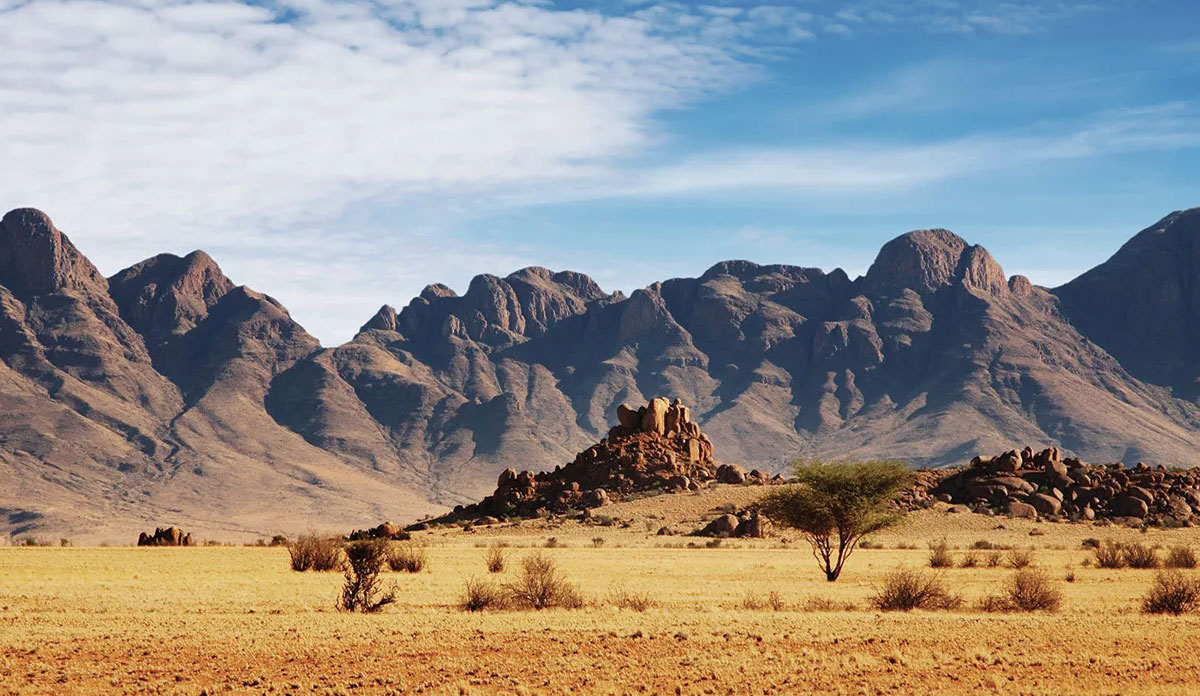
Located in Southern Africa, Namibia is geographically so much diverse, it has varied landscapes, large sand dunes, and beautiful coastal beaches. Here facts based on the geography of this country, that you will witness on your Namibia Tours.
Location:
Namibia is a country located in southern Africa, bordered by Angola to the north, Zambia and Zimbabwe to the northeast, Botswana to the east, South Africa to the south and the Atlantic Ocean to the west.
Size:
Namibia has an area of approximately 825,418 square kilometres (318,696 square miles), making it the 34th largest country in the world.
Landscape:
The country's landscape is characterized by vast desert regions, including the Namib Desert, the oldest desert in the world, as well as savannah grasslands, rugged mountain ranges, and coastal plains.
Climate:
Namibia has a dry climate, with hot summers and mild winters. The country receives very little rainfall, and some regions are among the driest in the world.
Wildlife:
Namibia is home to a diverse range of wildlife, including elephants, lions, leopards, giraffes, zebras, and many species of antelope.
Rivers:
The Orange River is the longest river in Namibia, forming the country's southern border with South Africa. Other major rivers include the Kunene, Okavango, and Zambezi.
Highest point:
Namibia's highest point is Brandberg Mountain, which rises to a height of 2,573 meters (8,439 feet) in the northwest of the country.
Coastal features:
Namibia has a long coastline stretching for over 1,500 kilometres2 miles), characterized by rugged cliffs, sandy beaches, and the Skeleton Coast, known for its shipwrecks and seal colonies.
Natural resources:
Namibia is rich in natural resources, including diamonds, uranium, copper, and gold.
Population density:
Namibia has a relatively low population density, with a population of around 2.5 million people spread across a large area of land. The majority of the population lives in urban areas such as Windhoek, the capital city.
Namibia Climate And Weather
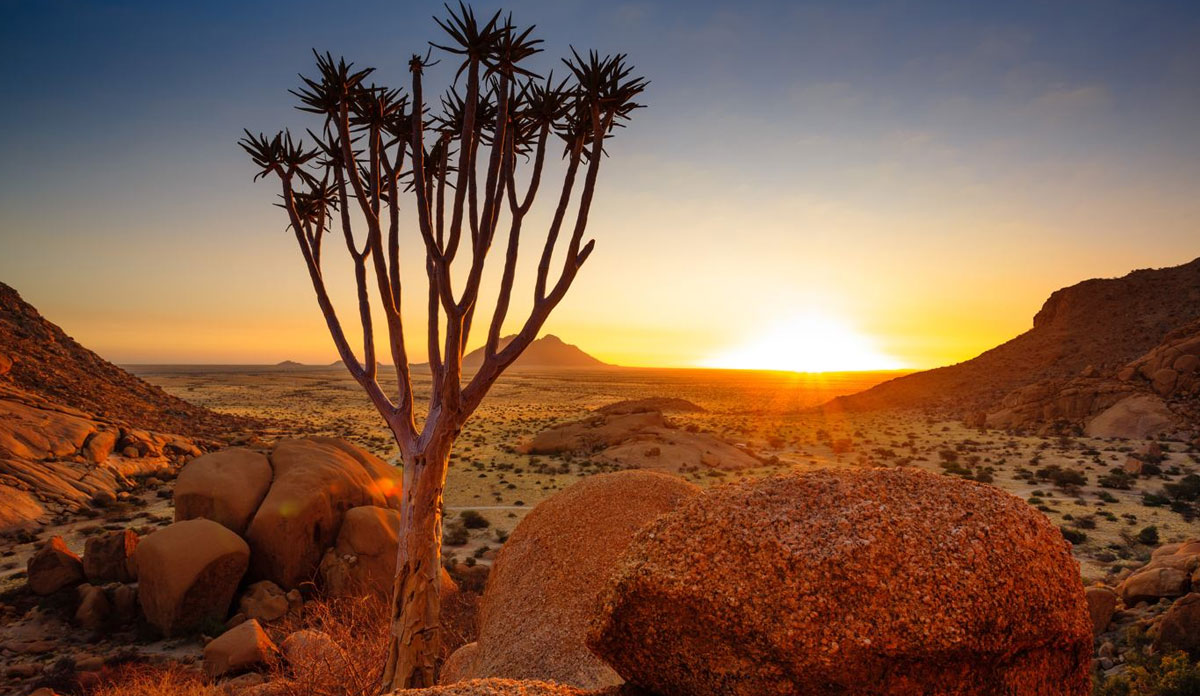
Namibia experiences a sub-tropical climate. Even after most part of this country is covered with deserts, the climate does not seem to be too much hot and unbearable. In fact, a cold current flow throughout the country which makes the climate cooler and drier.
Here are some climate and weather facts that will help you understanding Namibia’s climate and weather patterns.
- Namibia has two main seasons: a dry season from May to October, and a wet season from November to April. The dry season is characterized by clear blue skies, warm days, and cool nights, while the wet season is characterized by hot and humid weather, thunderstorms, and occasional flooding.
- The average annual rainfall in Namibia is only around 300 mm, with the coastal regions being the driest and the northeastern regions being the wettest.
- The coastal regions of Namibia are cooled by the Benguela Current, resulting in a cool and foggy climate. The inland areas are much hotter, with temperatures increasing the further away from the coast you go.
- Namibia is known for its sand dunes, which are formed by wind and have a unique reddish color. These dunes can reach heights of up to 300 meters and are found in various parts of the country, including Sossusvlei and the Namib Desert.
- The Harmattan winds, which blow from the Sahara Desert in West Africa, can reach Namibia in the winter months and bring with them dry and dusty conditions.
- Namibia is one of the sunniest countries in the world, with an average of 300 days of sunshine per year. Did you know one of these Namibia Travel Facts before?
- Despite its arid climate, Namibia has a diverse range of plant and animal species, adapted to survive in the harsh conditions. Some of these include the welwitschia plant, the desert elephant, and the black rhinoceros.
- The cold Benguela Current that flows along the Namibian coast also supports a rich fishing industry, particularly for hake and other deep-sea fish.
Namibia Attraction Facts
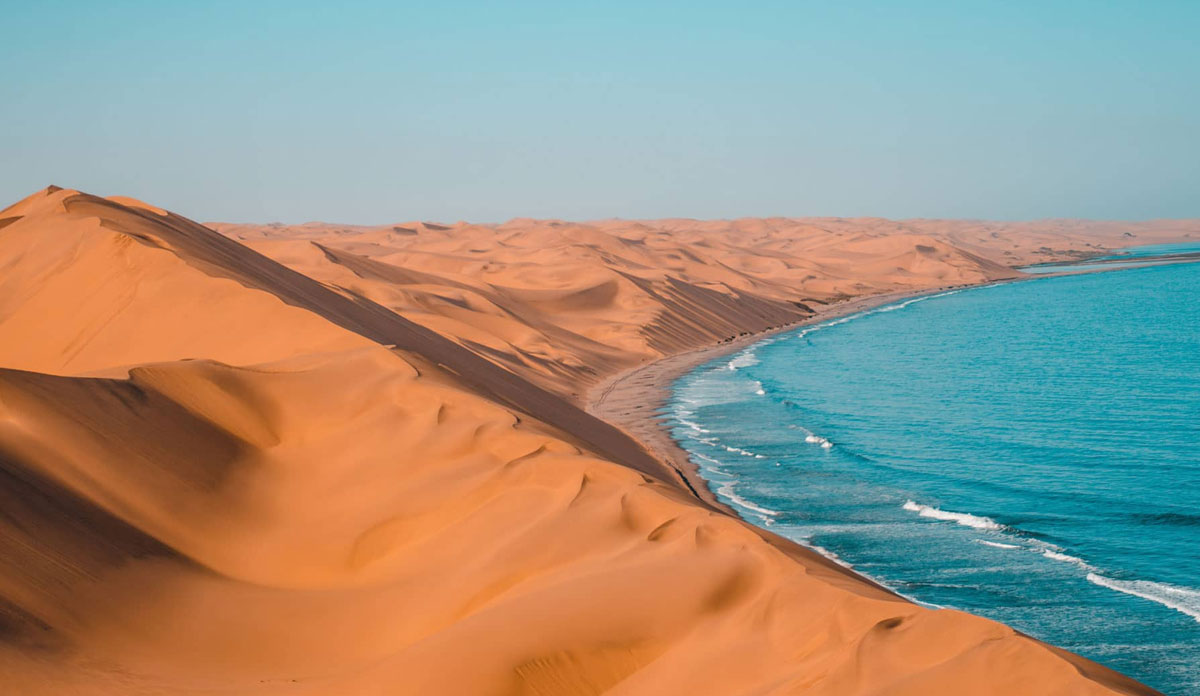
Namibia is a beautiful country with a wide range of attractions for tourists. Here are some facts about some of the top attractions in Namibia:
Etosha National Park:
Located in the northwestern part of Namibia, Etosha National Park is one of the country's most popular tourist and most desired Namibia Safaris destinations. It is home to a variety of wildlife, including elephants, lions, cheetahs, and rhinos.
The park covers an area of around 22,000 square kilometers and is known for its large salt pan, which is visible from space.
Sossusvlei:
Sossusvlei is a salt and clay pan located in the southern part of the Namib Desert. It is surrounded by some of the world's tallest sand dunes, which are a popular attraction for tourists, that can be discovered during your Namibia Tours. The dunes are known for their striking red color, which is caused by iron oxide in the sand.
Fish River Canyon:
The Fish River Canyon is one of the largest canyons in the world and one of the top Attraction In Namibia, with a length of around 160 kilometers and a depth of up to 550 meters. It is located in the southern part of Namibia and is a popular hiking destination, with a 5-day trail that takes visitors along the canyon floor.
Skeleton Coast:
The Skeleton Coast is a stretch of coastline in the northern part of Namibia that is known for its shipwrecks, sand dunes, and rugged terrain. It is also home to a variety of wildlife, including seals, dolphins, and desert-adapted elephants.
Swakopmund:
Swakopmund is a coastal town in central Namibia that is popular with tourists for its German colonial architecture, wide range of outdoor activities, and proximity to the Namib Desert. Activities in the area include sandboarding, quad biking, and skydiving.
Twyfelfontein:
One of the most fascinating Namibia Travel Facts is about Twyfelfontein. It is a UNESCO World Heritage Site located in the Kunene region of Namibia. It contains one of the largest concentrations of rock art in Africa, with over 2,500 engravings and paintings dating back thousands of years.
Cape Cross Seal Reserve:
The Cape Cross Seal Reserve is located along the Skeleton Coast and is home to a large colony of Cape fur seals. Visitors can observe the seals from a viewing platform and learn more about their behaviour and habitat.
Damaraland:
Damaraland is a region in northwestern Namibia known for its rugged landscapes, unique rock formations, and desert-adapted wildlife such as the desert elephant and the black rhinoceros.
It is also home to several cultural attractions, including the Twyfelfontein rock art site and the Himba people, who are known for their distinctive hairstyles and body paint.
Namibia Wildlife Facts

Namibia’s deserts landscapes support a vast array of wildlife. From deserts- adapted elephants to endangered species like Black Rhinos, you can spot some of the most iconic animals on a Namibia Safari. Here are top seven wildlife facts that you should know along with Namibia Travel Facts.
Desert-adapted wildlife:
Namibia is home to a number of species that have adapted to survive in its harsh desert environments. These include the desert-adapted elephant, which can go for days without water and has a longer stride than other elephants to cover more ground in search of food and water.
Endangered species:
Namibia is home to several endangered species, including the black rhinoceros, cheetah, and African wild dog. Conservation efforts are ongoing to protect these species and their habitats.
For more information on black rhino conservation check out this website -
https://www.worldwildlife.org/places/namibia
Birdlife:
Namibia has a diverse array of bird species, with over 630 recorded species. Here is a numbers of bird species that can be found in varied landscapes of Namibia.
Coastal wildlife:
Namibia's coastline is home to a variety of marine life, including dolphins, seals, and whales. The Cape fur seal colony at Cape Cross is one of the largest in the world, with up to 200,000 seals gathering there during the breeding season.
Unique species:
Namibia is home to several unique species that are found nowhere else in the world. These include the Hartmann's mountain zebra, the black-faced impala, and the desert lion, which has a lighter coat and larger body than lions found in other regions.
Namibia National Parks Facts
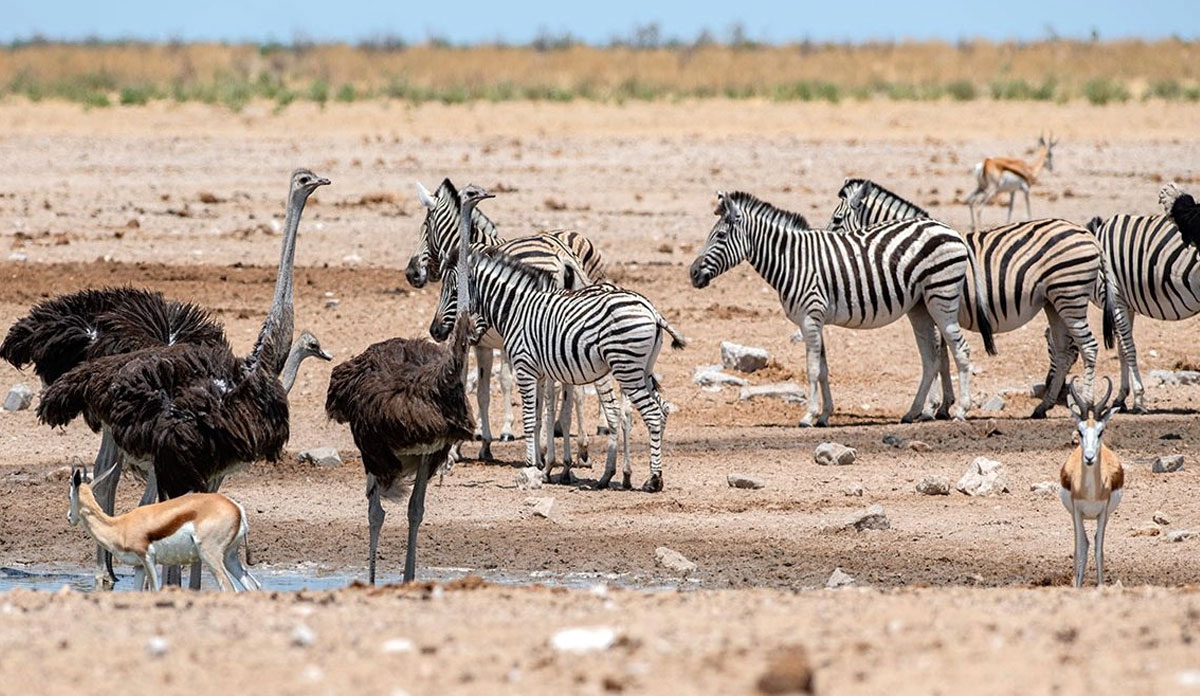
Namibia is home to some of the most incredible national parks in Africa, offering visitors the chance to see unique wildlife and landscapes. Here are some facts about Namibia's national parks:
- Etosha National Park is Namibia's most famous national park and one of Africa's largest game reserves. It is home to a variety of wildlife, including elephants, lions, leopards, and black rhinos.
- Namib-Naukluft National Park is one of the largest national parks in Africa, covering an area of over 49,000 square kilometers. It includes the famous Sossusvlei sand dunes, which are some of the highest in the world.
- Skeleton Coast National Park is located along Namibia's Atlantic coast and is known for its rugged, windswept landscapes and shipwrecks.
- Bwabwata National Park is located in northeastern Namibia and is home to a variety of wildlife, including elephants, lions, and hippos.
- Mudumu National Park is situated in the Caprivi Strip and is known for its wetlands and birdlife, including the rare and endangered Wattled crane.
- Namibia's national parks are also home to a number of endangered and threatened species, including black and white rhinos, African wild dogs, and cheetahs.
- The national parks offer a variety of activities for visitors, including game drives, hiking, camping, and birdwatching.
- Namibia's national parks are managed by the Ministry of Environment, Forestry, and Tourism, which works to protect the parks and promote sustainable tourism.
- In recent years, Namibia has become a leader in community-based conservation, which involves working with local communities to manage natural resources and promote conservation.
- Visiting Namibia's national parks is an unforgettable experience that offers visitors the chance to see some of Africa's most incredible wildlife and landscapes.
Namibia National Parks At A Glance.
|
National Parks |
Location |
Size |
Main Attractions |
|
Etosha National Park |
Northern Namibia |
22,270 km² |
Wildlife viewing (lions, elephants, zebras, etc.) |
|
Skeleton Coast National Park |
Coastal Namibia |
16,845 km² |
Desert landscapes, shipwrecks |
|
Namib-Naukluft National Park |
Central Namibia |
49,768 km² |
Sand dunes, hiking, wildlife |
|
Waterberg Plateau Park |
Northern Namibia |
405 km² |
Hiking, birdwatching, wildlife |
Namibia Safari Cost Of Transportation
The rolling landscapes of Namibia, offers brilliant photographic opportunities. If you’re on a Namibia Safari, do not take forget to pack a good camera with better focal length.
Here’re some photographic facts in Namibia.
Scenic Locations:
Namibia is known for its beautiful landscapes, including the Namib Desert, Sossusvlei sand dunes, Fish River Canyon, and Etosha National Park, which offer great opportunities for landscape photography.
Wildlife Photography:
Namibia is also home to a wide variety of wildlife, including lions, cheetahs, zebras, giraffes, and elephants, making it an ideal destination for wildlife photography.
Night Sky Photography
Namibia's clear skies and lack of light pollution make it an ideal destination for astrophotography. The country has several designated stargazing sites, including the Gamsberg and Tivoli observatories.
Cultural Photography
Namibia's diverse cultures, including the Himba, Herero, and San, offer opportunities for cultural photography, capturing traditional dress, dance, and customs.
Photography Tours
Several tour operators in Namibia offer photography tours, led by professional photographers who know the best locations for capturing stunning images.
Equipment
It's important to bring appropriate camera equipment for photography in Namibia. This may include a tripod for landscape and night sky photography, a telephoto lens for wildlife photography, and protective gear for dust and sand in desert environments.
Light Conditions: The harsh light conditions in Namibia, particularly during the middle of the day, can be challenging for photography. It's important to plan photography outings during the early morning and late afternoon to capture the best light.
Permits: In some cases, visitors may need permits to photograph certain areas or subjects in Namibia. This may include commercial photography or photographing cultural sites. It's important to check with local authorities for permit requirements.
Etiquette: It's important to be respectful of local cultures and people when taking photos in Namibia. Always ask for permission before photographing individuals, and avoid taking photos in sensitive cultural or religious sites without permission.
Namibia Food Facts
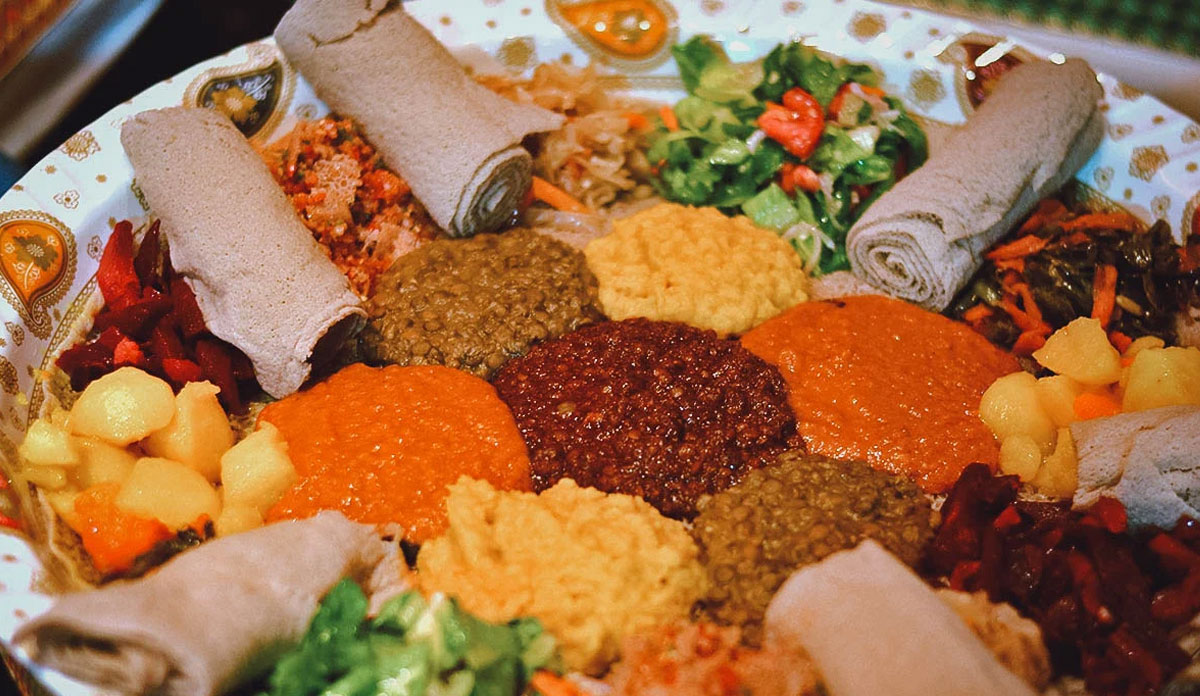
Namibia Food resembles the country’s rich traditions and culture. And, Namibia cuisine is highly inspired by German and South- African dishes.
- Namibian cuisine is heavily influenced by the country's German colonial history, as well as its indigenous cultures such as the Himba, Herero, and San peoples.
- One of the most popular dishes in Namibia is called "kapana," which is grilled meat (usually beef) served with chili and spices.
- Another popular dish is "potjiekos," a stew made with various meats and vegetables that is cooked in a cast iron pot over an open fire.
- Seafood is also a significant part of Namibian cuisine, with dishes such as fish curry, grilled kabeljou (a type of fish), and oysters being popular.
- Mopane worms, a type of caterpillar, are a traditional delicacy in Namibia and are often served grilled or fried.
- Namibian beer, particularly Windhoek Lager, is widely consumed and considered to be of high quality.
- Biltong, a type of dried meat similar to beef jerky, is a popular snack in Namibia.
- "Pap," a type of porridge made from maize meal, is a staple food in Namibia and is often served with meat or vegetables.
- Traditional Himba cuisine includes dishes such as dried meat, sour milk, and porridge made from mahangu (a type of grain).
- Namibia is also known for its production of game meat, including kudu, ostrich, and springbok, which are often served in restaurants and lodges.
Here is tabular data on Namibia Foods, that can give you a quick overview on foods in Namibia.
Namibian Cuisine
|
Dish |
Description |
|---|---|
|
Biltong |
Dried, cured meat (usually beef) |
|
Potjiekos |
Stew cooked in a cast-iron pot over a fire |
|
Kapana |
Grilled or barbecued meat (usually beef or venison) |
|
Pap en Wors |
Maize porridge and sausage |
|
Mopane Worms |
Edible caterpillars, usually fried or cooked in a sauce |
|
Vetkoek |
Fried dough pastry, often filled with meat or cheese |
|
Oshifima |
Maize porridge, often served with meat and vegetables |
|
Rusks |
Hard, dry biscuits (often dunked in tea or coffee) |
Namibia Cultural Facts
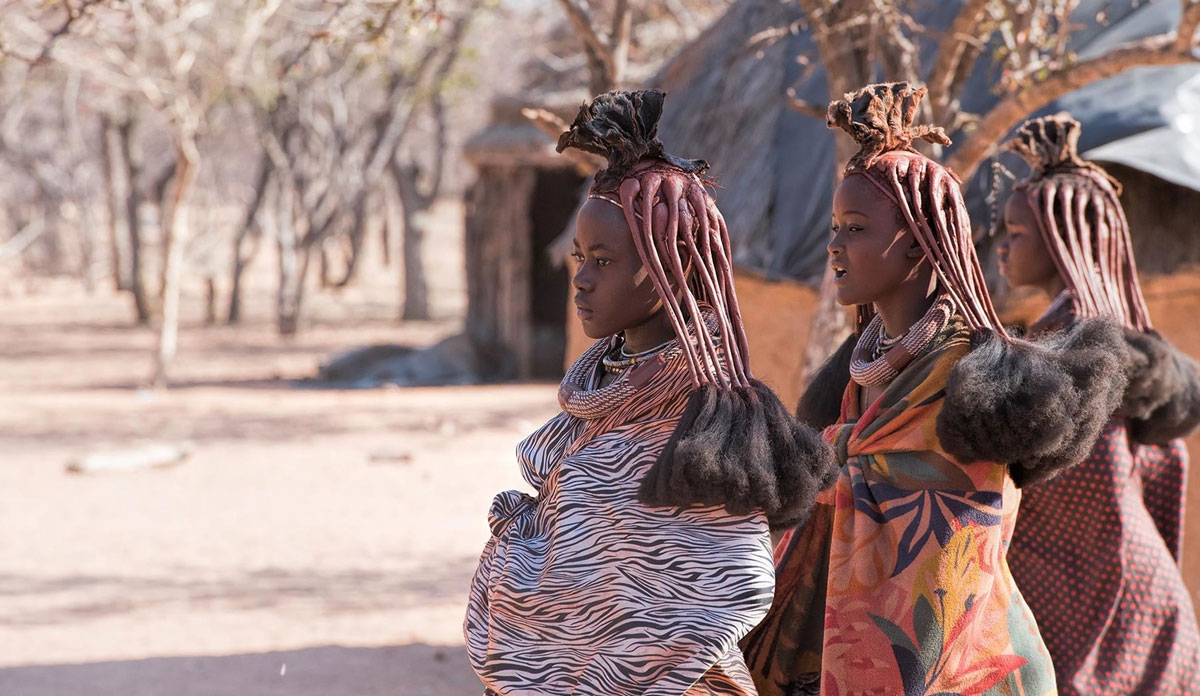
As you start exploring Namibia, you will be overwhelmed by the country’s vast and dynamic culture. Below are some cultural facts that reflect the country’s passionate people and their way of living.
And in the 7th point, you will find out how Namibian people celebrate their life.
Ethnic groups:
Namibia is home to many ethnic groups, including the Himba, Herero, Damara, San (also known as Bushmen), Ovambo, and Nama. Each group has its unique customs, language, and traditions.
Languages:
Namibia has multiple official languages, including English, German, Afrikaans, Oshiwambo, and Herero. There are also many other indigenous languages spoken in the country. Some of them are shikwanyama, Oshindonga, Rukwangali, Otjiherero, Rugciriku, Thimbukushu, Silozi, and Setswana.
|
Language |
Speakers (approx.) |
Main Regions |
|
Oshiwambo |
49% |
Northern regions |
|
Khoekhoe (Nama/Damara) |
11% |
Southern and central regions |
|
Afrikaans |
10% |
Urban areas |
|
Otjiherero |
7% |
Western regions |
|
Ovambo |
7% |
Northern regions |
|
English |
5% |
Urban areas |
|
Other (including German and Portuguese) |
11% |
Various regions |
Music and dance:
Music and dance are an important part of Namibian culture, with many different styles and rhythms. Traditional music is often played on instruments such as the omboroko and the thumb piano, while modern music styles like kwaito and hip-hop are also popular.
Art and craft:
Namibia has a thriving arts and crafts scene, with many talented artists and artisans producing a wide range of work. This includes traditional crafts such as pottery, weaving, and basketry, as well as contemporary art and sculpture.
Cuisine:
Namibian cuisine is influenced by a variety of cultures, including German, Afrikaans, and indigenous traditions. Common dishes include braaivleis (barbecued meat), biltong (dried meat), and kapana (grilled beef).
Traditional dress:
Many ethnic groups in Namibia have distinctive traditional dress, which is often brightly coloured and adorned with beads, shells, or other decorative elements.
The Herero women, for example, wear long Victorian-style dresses with large headdresses, while the Himba people wear little clothing and cover themselves in a mixture of red ochre and butterfat.
Cultural festivals:
Namibia has many cultural festivals throughout the year, celebrating everything from music and dance to food and crafts. These include the Windhoek Oktoberfest, the Himba Cultural Festival, and the Ovahimba Festival. Don’t miss all these festivals, on your Namibia Tour.
Traditional beliefs:
Many Namibians follow traditional animist beliefs, which involve a belief in the spiritual power of natural objects and places. The San people, for example, believe in the power of the eland antelope.
While the Himba believe in ancestral spirits and the importance of maintaining a connection to the land.
Namibia Festivals Facts
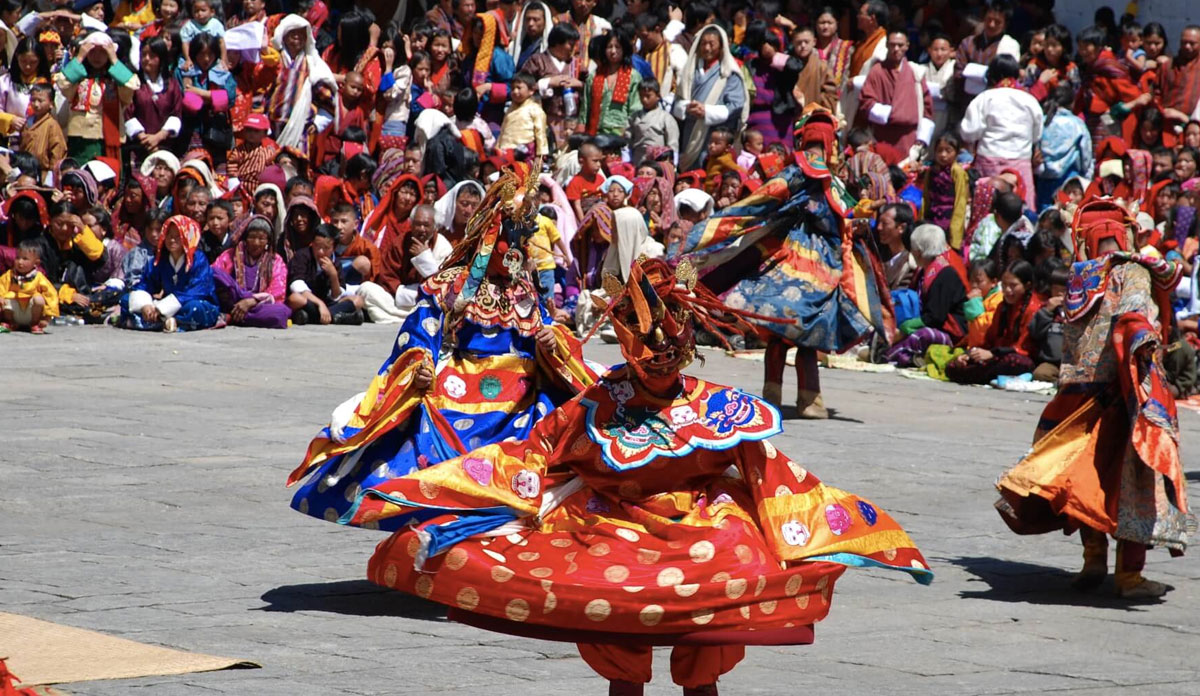
Just like, the other Namibia Travel Facts, below are some facts on Namibia festival facts, that, will let you know how Namibian celebrate their loud and colourful festivals.
Windhoek Oktoberfest
The Windhoek Oktoberfest is a popular German-inspired festival held in the Namibian capital city of Windhoek each year. It is usually held in late October and features traditional German food, music, and beer.
Namibian Independence Day
Namibian Independence Day is celebrated on March 21st each year to commemorate the country's independence from South Africa in 1990. It is a public holiday and is celebrated with parades, speeches, and cultural events.
Caprivi Arts Festival
The Caprivi Arts Festival is an annual cultural festival held in the Caprivi Strip region of Namibia. The festival celebrates the cultural heritage of the local communities and features traditional music, dance, and art.
The Namibian Music Awards
The Namibian Music Awards is an annual awards ceremony that recognizes the best in Namibian music. The awards are held in Windhoek and feature performances by popular Namibian musicians.
Namibian Annual Tourism Expo
The Namibian Annual Tourism Expo is the largest travel and tourism event in Namibia. It is held annually in Windhoek and attracts tourism professionals from around the world.
Desert Dash
The Desert Dash is an annual cycling race held in Namibia's Namib Desert. The race covers a distance of over 300 kilometers and is considered one of the toughest endurance races in the world.
Kalahari Desert Festival:
The Kalahari Desert Festival is a celebration of the San culture in the Kalahari Desert region of Namibia. The festival features traditional music, dance, and storytelling, as well as workshops on traditional skills and crafts.
Swakopmund Arts Festival
The Swakopmund Arts Festival is an annual arts festival held in the coastal town of Swakopmund. The festival features music, theater, and visual arts performances and workshops.
Walvis Bay Bird Festival
The Walvis Bay Bird Festival is an annual bird-watching event held in the coastal town of Walvis Bay. The festival celebrates the diverse bird species found in the region and offers guided tours and educational programs.
Wild Cinema:
Wild Cinema is an annual film festival in Namibia that showcases documentaries and films related to conservation, wildlife, and the environment. The festival aims to raise awareness of environmental issues and promote conservation efforts in Namibia
Namibia Adventure Activities

From skydiving over the skeleton coast to quad biking in Namibia’s famous deserts, Namibia Tours offers, tailor-made adventure experiences.
Sandboarding:
Namibia's vast desert landscapes make it an ideal destination for sandboarding, an activity that combines the thrill of snowboarding with the unique experience of surfing on sand dunes.
Quad biking:
Another popular activity in Namibia is quad biking, which allows visitors to explore the country's stunning desert landscapes at high speeds.
Skydiving:
For those seeking an adrenaline rush, Namibia offers the opportunity to experience skydiving over the stunning desert landscapes.
Hot air balloon rides:
Taking a hot air balloon ride over the Namibian desert provides an unforgettable perspective on the country's natural beauty.
Hiking:
Namibia has a number of hiking trails, ranging from the challenging Fish River Canyon hike to the more moderate trails in the Waterberg Plateau Park.
Wildlife safaris:
Namibia is home to a diverse range of wildlife, and visitors can experience it up close on a wildlife safari, either by vehicle or on foot.
Canoeing:
The Orange River, which forms the border between Namibia and South Africa, provides a picturesque setting for canoeing and kayaking.
Horse riding:
Horse riding is a popular way to explore the Namibian countryside, providing a unique perspective on the landscape and the chance to spot wildlife.
Scuba diving:
The coastal town of Swakopmund offers the opportunity to explore the underwater world off the Namibian coast, with a variety of marine life and shipwrecks to discover.
Bungee jumping:
For those seeking the ultimate adrenaline rush, bungee jumping is available at the Gouritz Bridge on the border between Namibia and South Africa.
Namibia Conservation Facts
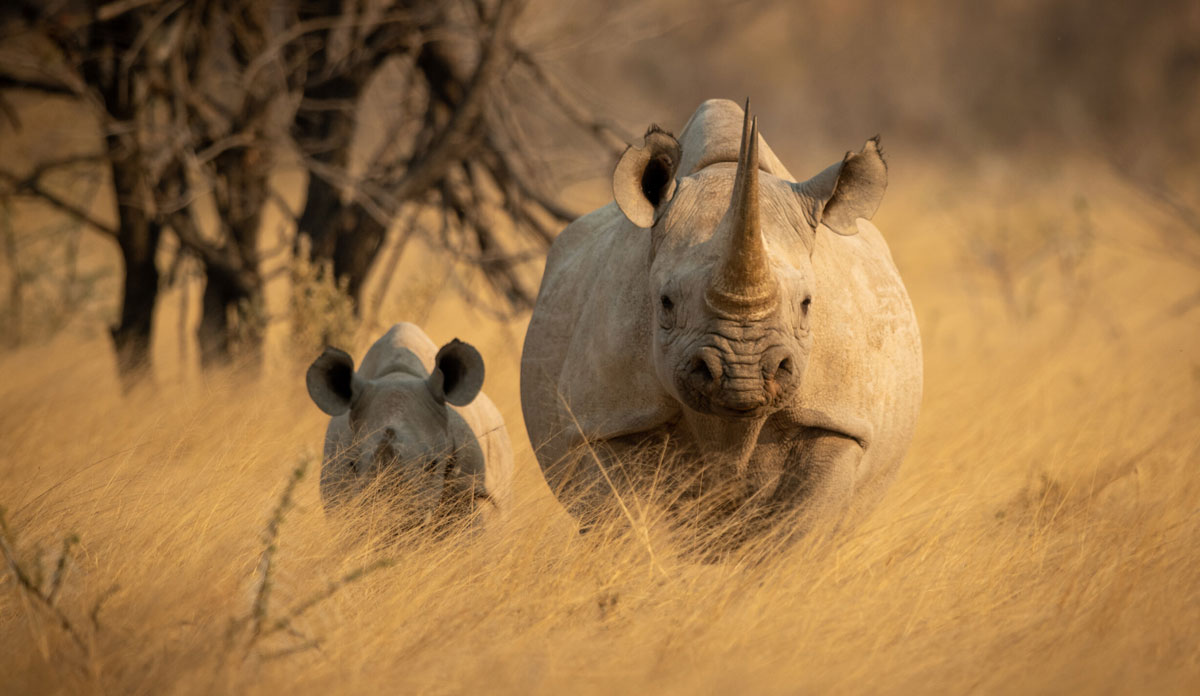
Namibia has made significant efforts in conservation and established itself as a leader in conservation efforts in Africa. Here are some conservation facts about Namibia, that are add on to the Namibia Travel Facts.
- Namibia is home to some of the world's most diverse wildlife, including elephants, lions, cheetahs, giraffes, and rhinos.
- Namibia has implemented successful conservation programs, resulting in an increase in wildlife populations, including black rhinos and desert elephants.
- Community-based conservation programs have been established in Namibia, allowing local communities to benefit from wildlife tourism and reducing conflicts between humans and wildlife.
- Namibia has established several national parks and conservancies, including the Etosha National Park, which is home to over 100 mammal species.
- Namibia has implemented sustainable tourism practices, such as eco-tourism and responsible wildlife viewing, to minimize negative impacts on the environment and wildlife.
- Namibia has implemented strict regulations on the hunting of other species, including lions and leopards, to ensure their populations remain stable.
- Namibia has implemented a successful program to combat poaching, resulting in a decline in the number of poached rhinos and elephants.
- Namibia is home to the world's largest population of free-roaming cheetahs, and conservation efforts have helped to stabilize their populations.
- Namibia's conservation efforts have also helped to protect its unique and diverse ecosystems, including the Namib Desert and the Skeleton Coast.
Namibia Travel Requirements Facts
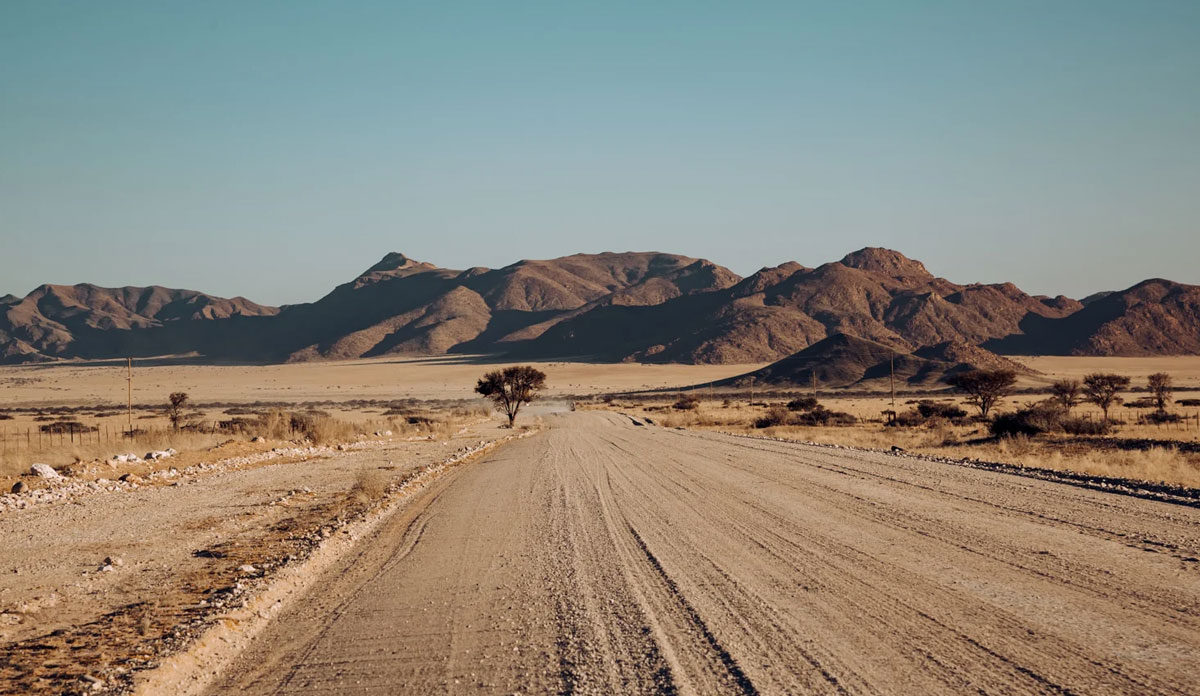
Before embarking on your Namibia Tours, here are some essential information like visa requirement, health precaution and safety tips, that will make your travel experience smoother and comfortable.
Tourists traveling up to 3 months, you don’t need a visa to enter Namibia. For more information on visa processing and all, you can check the following website-
https://kenya.visaonlinegov.org/apply-visa
If you’re travelling with your children, carry a full-birth certificate and, and an affidavit.
Yellow fever vaccine certificate is mandatory to enter to Namibia. Get vaccinated before arriving Namibia.
We suggest you to have book a travel insurance before coming to Namibia, and make sure it covers all medical emergencies like medical evacuations.
Although Malaria is not an issue in Namibia, it is advisable to carry insect repellent to keep you safe throughout the journey.
Nambia Travel Is Waiting For You!
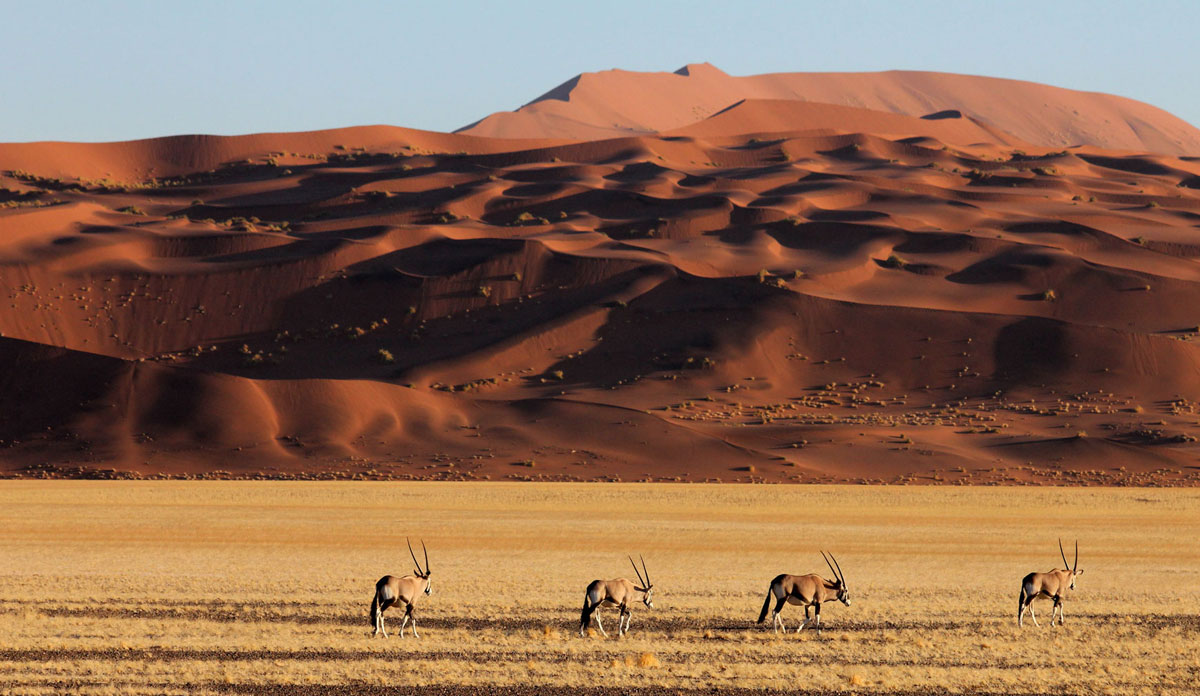
Visitors often finds Namibia as a harsh landscape, with barren deserts, but when they start exploring this country, they find most extraordinary wildlife, that have adapted to extreme condition of Namibia.
We hope all these Namibia Travel Facts must have given you much insights on country’s contrast culture, vast wildlife and the beautiful landscapes that creates a panoramic view. But reading all this is not enough, you have to experience it, for that you need to book a Namibia Safaris.
So, book your next safari with us, get ready for the ultimate adventure in Namibia!
Namibia
Travel Facts
Glimpse Of Namibia Travel Facts
Namibia Geographical Facts
Namibia Climate And Weather
Namibia Attraction Facts
Namibia Wildlife Facts
Namibia National Parks Facts
Namibia Photography Facts
Namibia Food Facts
Namibia Cultural Facts
Namibia Festivals Facts
Namibia Adventure Activities
Namibia Conservation Facts
Namibia Travel Requirements Facts
Namibia Is Waiting For You!
Related Namibia Travel Guide
We Think You’ll Love
Frequently Asked Questions
We Think You’ll Love
Namibia is located in southern Africa, bordered by the Atlantic Ocean to the west, Angola to the north, Zambia to the northeast, Botswana to the east, and South Africa to the southeast and south.
The capital of Namibia is Windhoek. With over a population of 431,000, Windhoek is the largest city in Namibia.
The official language of Namibia is English, although several indigenous languages are also widely spoken, including Oshiwambo, Otjiherero, and Khoekhoe.
The currency of Namibia is the Namibian dollar (NAD). Visitors to this country can use Mastercard and visa, as these two cards are widely accepted in all major cities.
Namibia has a dry climate with very little rainfall throughout the year. The coastal regions are usually cool and damp, while the inland areas are hot and dry.
Namibia has several popular tourist attractions, including Etosha National Park, Sossusvlei, Fish River Canyon, the Skeleton Coast, and the Caprivi Strip.
Namibia is generally considered a safe country to travel to. However, visitors should exercise caution and take the usual precautions to avoid becoming a victim of crime, especially in urban areas.
Yes, of course, Namibia is safe to travel with kids and family, and it’s a great safari destination for families. Namibia offers a wide range of activities, for every generation. From wildlife safari to adventure activities, you will have a lot to discover and experience, during your Namibia Safaris.
Brandberg Mountain, standing at 2573 meters, it is the highest point in Namibia. This mountain is located in the northwestern part of this country.
May to October, if you’re planning a Namibia Tour, the dry season (from May to October) is the best time. Generally, the game-viewing experience remains superb during these months.
Namib desert, Namibia got its name from Namib, deserts, one of the oldest deserts. This desert is existed for over a million year.
Namibia is home to world’s largest population free-roaming cheetahs. Nearly 2500 -3000 numbers of cheetah can be found in Namibia. Apart from cheetah, Namibia is home to others animals, like black rhinos, giraffes and ostrich, zebra and many others.
The Fish River Canyon, in Namibia is the second largest canyon in the world after, the Grand Canyon. Researchers believe that canyon was formed 500 million years ago.
Over 1700, species of animals live in Namibia’s desert landscapes. And, what’s even more interesting is, large mammals like elephants are also part its ecosystem.
We are thrilled to help you plan your perfect safari holiday
We'd be delighted to help you with any questions you have about properties & safaris. Please fill in the form below so that we can help you create your perfect safari holiday.
Or
Contact Us
Feel free to give us a call or send us an e-mail:
Start Planning Your Tailored African Safari

Expert Safari Knowledge
With decades of expertise, we're your trusted safari guides, ensuring every moment exceeds your expectations.

Tailor-made African Safaris
Tailored to your preferences, our African Safaris guarantee an adventure perfectly suited to your desires.

Long-term Relationships
Our enduring partnerships across Africa provide exclusive access and authentic experiences.

Carefree Travel
Leave your worries behind and accept carefree travel with Falcon Safaris, where every detail is handled to perfection.
Our Travelers Say

We travelled with Falcon Safaris in Zimbabwe and Botswana for 16 days. Falcon designed a wonderful trip with private guide to the most interesting sites in both countries. The organization of the whole trip was excellent, flights within the country, accommodation and activites. The guides were very knowledgable and told us a lot about the countries, their history, people, economy and much more. We visited the Great Zimbabwe Ruins, the Victoria Falls Tour and a number of national parks in both countries.
Rhino tracking was a real adventure! We had tremendous further game drives and saw very many animals - we did the Big Five. We had much more Victoria Falls Activities than planned and enjoyed very much.We strongly recommend Falcon Safaris to everyone planning a trip to Southern Africa and East Africa.
Wonderful trip to Zimbabwe and Botswana with excellent organization and very competent guides

Our Consultant Vimbai was very helpful and accommodating. We stayed at the Elephant hills hotel which was nothing short of amazing.Our activities included a helicopter flight, dinner cruise as well as a morning game drive. All the activities were absolutely amazing.
Exceptional!

We worked with Gertrude to schedule and organize everything and she did an excellent job. I asked a lot of questions via e-mail and she answered everyone in a timely helpful manner. Our guide at Victoria Falls was also great. He met us at the airport, provided a thoughtful tour of the Falls and got us to our next guide in Botswana. Our lodgings at River View Lodge were just as described- very comfortable and excellent food. All the staff were so pleasant and helpful. If I had to do it again I would arrange a morning boat ride as well. We only did the sunset boat rides and they were the high point of our entire trip- we saw so many animals and our guide was very knowledgeable. Just a great experience. Our lodgings at Oddball's Enclave was rustic and we loved it. So great to disconnect from the world for a bit. Leo, our guide, was the best - got us out and about, saw fantastic wildlife and got back to camp safely each time. Doc manages the camp so well. This whole trip was planned and organized by Falcon Safaris and we could not have been happier.
Fabulous, well planned trip

Falcon safaris have given my the correct advice with excellent service. The only suggestion will be to work closer with the lodges to confirm bookings as soon as possible. We have booked and pay our deposit a year in advance. We have only receive our final convermation from Chobe Safari lodge a week before departure. I do realize its not within your controle but with limit alternatives and a group of 14 people it becomes an issue to find alternative accomodation if the booking was cancelled.
Excellent and efficient service
Explore Our Africa With Customize Your Tour
We love Africa's diversity and create amazing trips for you. With 30+ years of experience, we customize every trip just for you.

